Hello, all—
I’ve been a fan of Tom Lichtenheld’s books since picking up DUCK! RABBIT! many moons ago, one of his many collaborations with the multitalented and much-missed Amy Krouse Rosenthal, who passed away in 2017. His books are funny, smart, eye-catching, kid-friendly and highly-acclaimed—and more than a few have wound up on the New York Times Best Sellers list. Here’s just a sampling:
In the last year or so, Tom has had three new books published, and saw another collaboration with Amy—YES DAY!—transformed into a film version on Netflix.
I’m thrilled that Tom agreed to come over for a chat and grateful for his generosity in spending time with us. So grab a cup of coffee (or beverage of choice) and settle in. Here’s Tom…

LA: Congratulations on the new books and Netflix film! Still it’s been quite a year—and we’re not totally out of the pandemic woods yet. How are you doing?
TL: I can’t complain (and yet I do). The pandemic is disturbing but I already worked from home, so it hasn’t changed my work situation much. I try to appreciate those who are on the front lines, keep those who are suffering in my thoughts, and help out when I can.
LA: You’re impressively versatile as an artist—animals, people, construction equipment, sticks, stones, clouds, numbers, letters, punctuation! And, wow, I love all those dancing cows in the MOO-MOO, I LOVE YOU! endpapers. Are there particular subjects and characters you especially enjoy illustrating? Anything you never want to illustrate again?
TL: Thank you for the compliment. I don’t think of myself as versatile, rather, I think of myself as untrained and inconsistent. That said, I try to use a technique for each book that matches its subject and mood. For example, the CONSTRUCTION SITE books are done in a gritty style, on textured paper with jagged black lines, which fits the subject matter. On the other hand, an emotional book like I WISH YOU MORE calls for a softer technique, so I used watercolor and chalk pastels. The dancing cows are done in a brush pen, which is loose and expressive (like dancing cows?).
Endpaper patterns like this are fun to create because there’s no storytelling to be done, so I can just draw. When kids ask me how to get good at drawing, I tell them to draw animals in motion. If you can draw a running dog, drawing a static house is a piece of cake. By the way, if anyone needs to know how a running dog should be drawn, check out the book A DAY A DOG, by Gabrielle Vincent. It’s brilliant.
As for what I like to draw, I am happiest when sketching out a book: figuring out pagination, page breaks and the overall visual dynamics of the story. At that stage, everything is loose, and perfection is still a possibility. But, when I start to create the final art, that’s when the failing and compromises begin, so I’m very good at procrastinating at that stage. I’m also terrible at character continuity so it’s a challenge for me to create books with the same character throughout.
LA: I imagine you’re offered lots of illustrating opportunities. How do you decide what to work on?
TL: I have a system for this. When I get a manuscript, I print it and read it slowly with pencil in hand. If the story motivates me, I’ll start doodling right there on the manuscript. If it really grabs me, I’ll spend a few hours sketching out some scenes. An example of this is STICK & STONE, by Beth Ferry [who also visited PBB a while back]. I still have the original printed manuscript with doodles all over it (see below). Also, if a manuscript makes me laugh or cry, sign me up.
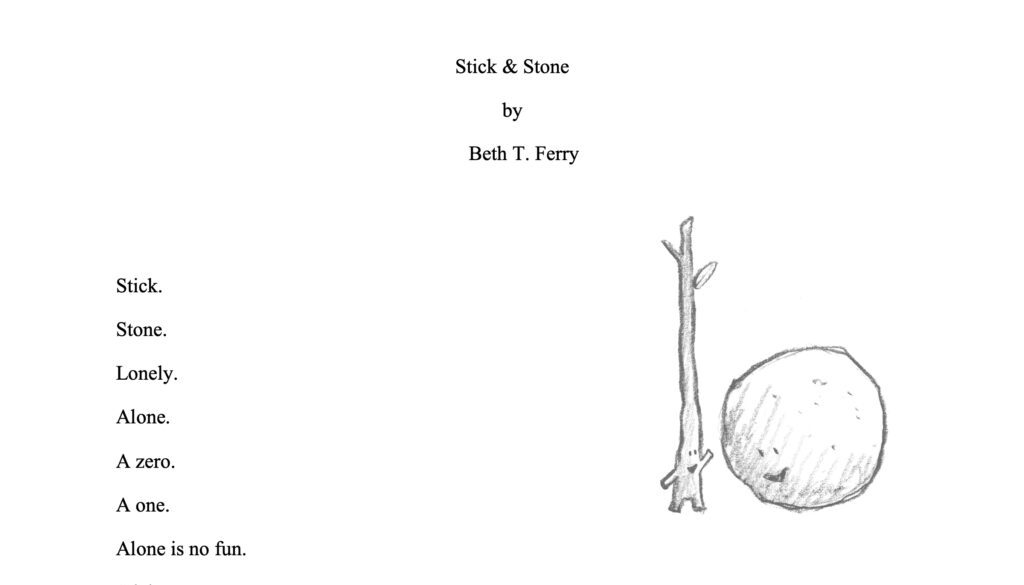
LA: Wow, they hardly changed at all from that first doodle! I love Julie Rowan-Zoch’s illustrations for LOUIS. Was this the first time someone else illustrated a book you’d written? What was that like?
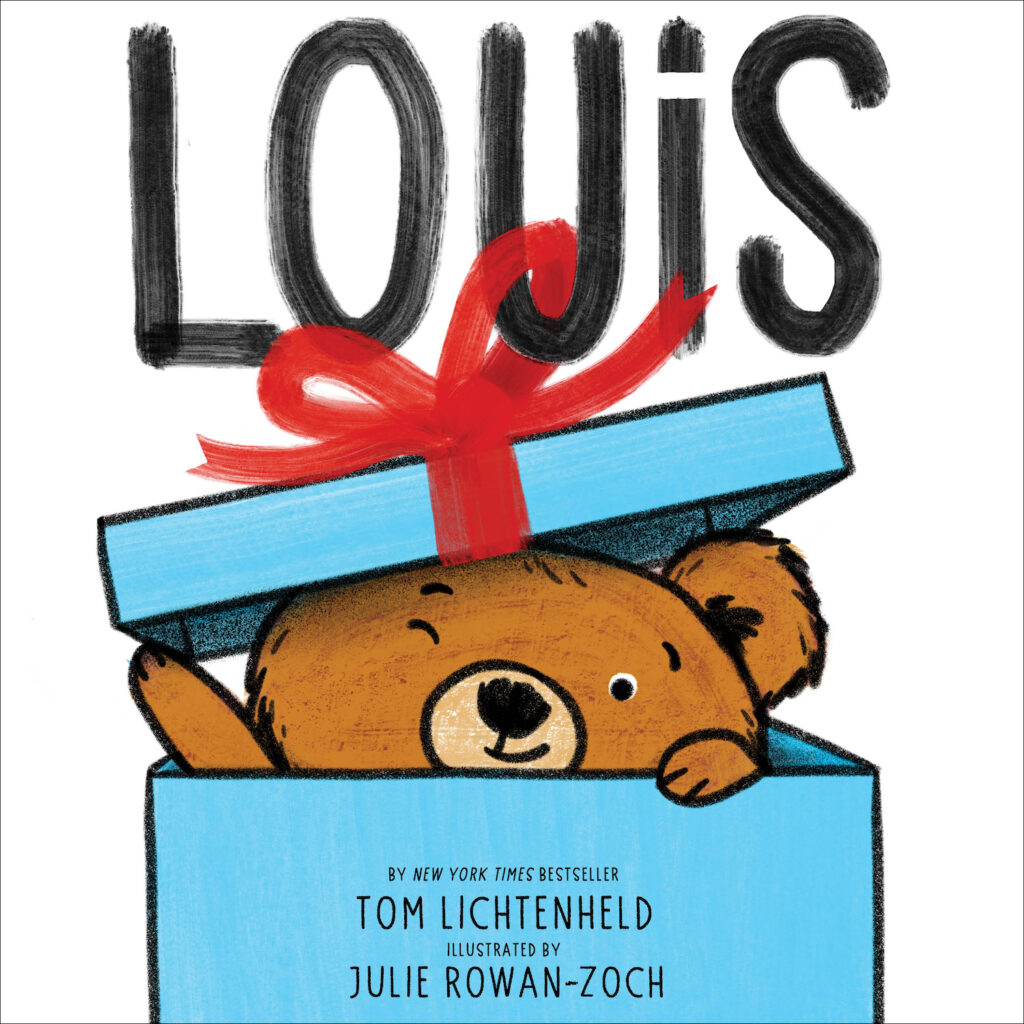
TL: Yes, this was the first time someone else illustrated a book I’d written, and it was a wonderful experience. Julie’s depiction of Louis and her take on the story are perfect. As good illustrators will do, she also created a visual subplot that wasn’t in the manuscript. I’m usually not fond of all-digital art but Julie’s style – completely different than my own – is fresh and fun.
LA: Many picture book writers worry about how much detail to include in illustration notes. No one wants to cramp an illustrator’s creativity, but sometimes clarification is needed. Any thoughts about that? And how did you approach it for LOUIS?
TL: I agree that illustrators should be given the freedom to bring their point-of-view to the story. Clarification is needed when the text needs to be redefined by the illustrations, which is often the case in LOUIS, so I had to include some art notes on the manuscript. For instance, Louis’ complaints are all curmudgeonly exaggerations of normal situations. When he says “I’ve been left to the mercy of wild animals…” he’s shown being hugged by the family dog. Using a visual counterpoint like this gets the reader involved in the storytelling and, in the case of Louis, reveals the silliness of his disposition.
LA: I love Louis’s grumpy voice, and the language and rhythm of the spare text, as in this spread (one of my favorites in the book).
How do you approach writing vs. illustrating? Do you find one to be more challenging than the other?
TL: Writing LOUIS came naturally because he’s been hanging around with me for many years. All I had to do was let him air his grievances and build them into a storyline. Being an illustrator helped me tell a story where the character’s description of what’s going on is contradicted by the reality in the visuals.
As for writing vs. illustrating, writing is harder for me because it’s not my primary skill. I have great admiration for writers, and I have the luxury of only doing it when someone tells me one of my manuscripts is worthwhile.
LA: Many editors do their best to keep writers and illustrators from interacting with each other. You and Amy Krouse Rosenthal created so many wonderful, inventive books together over the years. How did that collaboration come about?
TL: A mutual friend introduced us. We first met at Millennium Park in Chicago, where she drew the word OK on her hand and pointed out that, turned sideways, it was a person. She asked me if I thought it could be turned into a book and I said “Yes, but only if I illustrate it!” (This became THE OK BOOK.) From there, Amy and I did nine books together, so that meeting changed my life. Working with Amy led to better books and an agent who helped me turn a sideline into a career. Collaborating with Amy was always an adventure. We would get together every six months or so and share our half-baked ideas, then collaborate on a few of them until something felt book worthy. The wonderful thing was that either of us could share an idea that had hit a dead end, then see if the other person could turn it into something. This is how I WISH YOU MORE (don’t miss Tom’s collaboration-process story here) and EXCLAMATION MARK happened. It’s wonderful having a partner who recognizes the essence of an idea then takes it in a direction you can’t find on your own. By the way, you’ll know you’re collaborating with the right person when your time working together feels like play and you can’t wait to do it again.
LA: I think we all dream of that sort of collaborative relationship. MOO-MOO, I LOVE YOU! is such a lovely tribute to Amy. The book was based on an earlier book you did together. I imagine it was a bittersweet process working on it. Can you tell us about it?
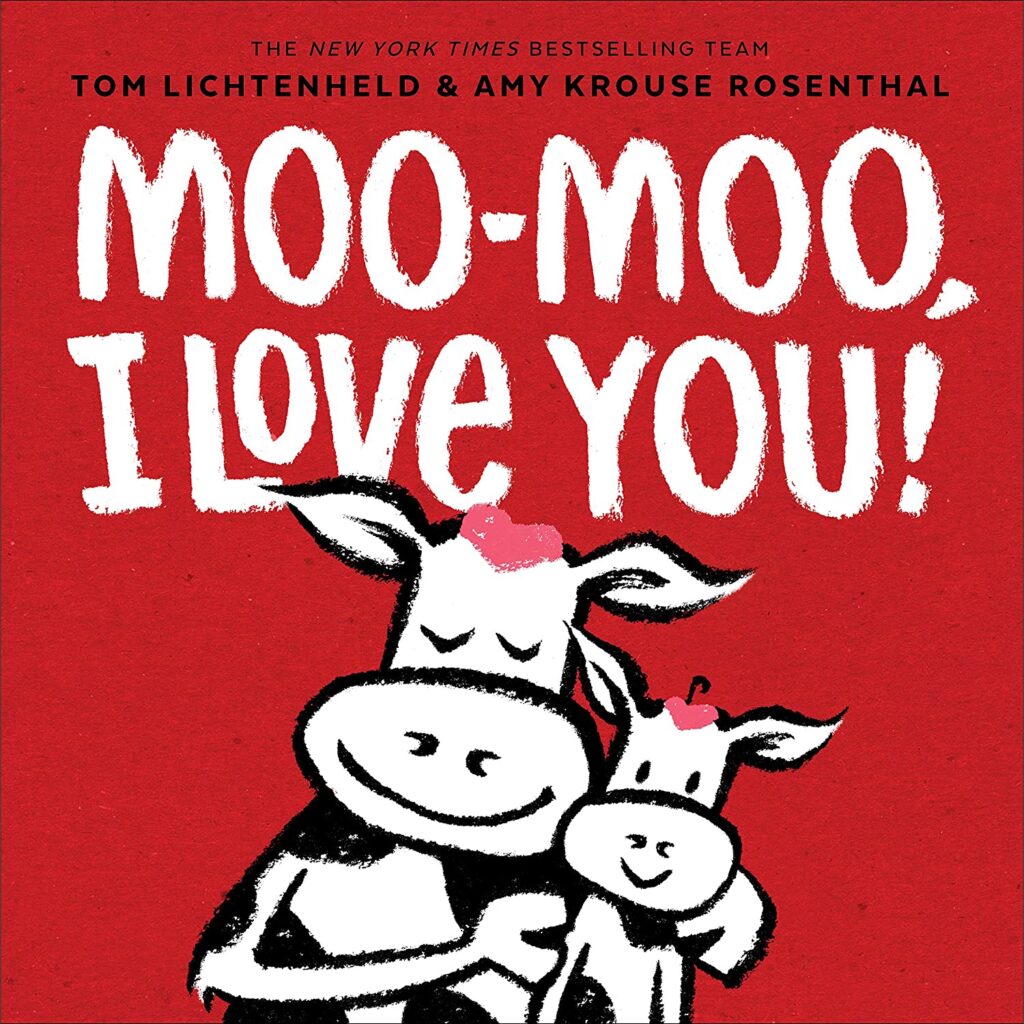
TL: The original book we did together was a pun-filled gift book for adults. Amy and I had toyed with the idea of doing a children’s book version of it but, after she passed away, I put it aside out of respect. A year or so later, I revisited it to see how it would feel.
To my surprise, it felt good, like I was channeling Amy’s voice, humor and love of connecting with children through books. At first, it was bittersweet but, shortly into the process, I realized Amy would only want the sweet side to come through, so it was an overall positive experience.
LA: What do you do to stay creatively inspired? Any special foods, rituals, exercise regimens, etc.?
TL: Mostly, I look at picture books. There are so many wonderful authors and illustrators right now that it’s intimidating and hard to keep up. I have my favorite picture books spread around the studio in hopes of absorbing some of their genius through osmosis.
There are three books I consistently go back to, for specific reasons:
- ALL THE WORLD, by Liz Garton Scanlon and Marla Frazee. This is my “desert island” picture book for its seamless totality of art, writing, design and message. As an illustration textbook, I call it “All The Illustrations” because it has a little bit of everything: people of all kinds, in all kinds of situations and moods, lovingly-depicted trees, water and other elements of the natural world, and my favorite car, the Nash Metropolitan.
- A SKETCHY PAST, about the work of Peter DeSeve. I go to this book when I feel myself getting lazy with my drawing. Drawing is as much about thinking as it is about draftsmanship and Peter’s work reminds me what is possible if I fully engage my brain. By the way, there’s an important distinction between inspiration and copying. I look at great illustrations not to copy them, but to find a benchmark to reach for.
- MY HOUSE, by Delphine Durand. This is a small picture book packed to the gills with goofy characters in an off-the-rails story. I reach for it when I feel myself getting too serious or literal.
When I’m stuck or uninspired, I get away from the studio and take a walk. The solution to a storyline or art problem is often hiding in the woods. When I’m really stuck, I talk with my wife, Jan, who has knack for coming up with solutions out of thin air, which is both a relief and exasperating.
LA: We love looking at creative people’s workspaces. Would you mind giving us a peek?

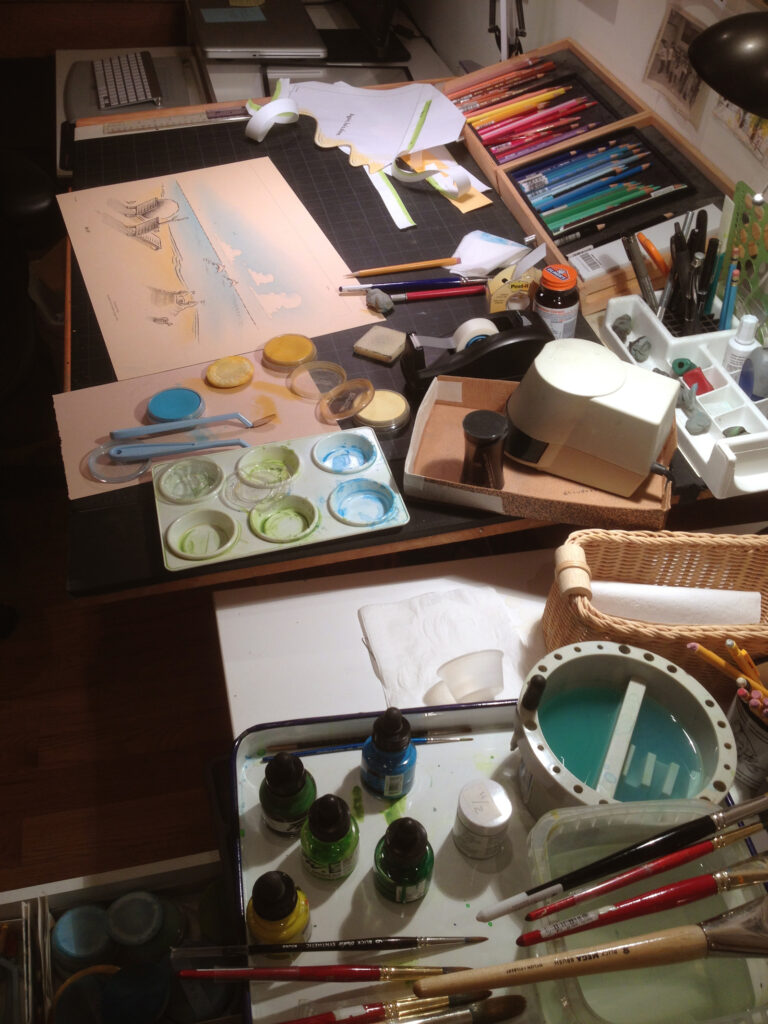
LA: Thanks for that! What’s up next for you?
TL: Beth Ferry and I created a sequel to STICK & STONE which comes out this fall. I love working with Beth and we have a number of things in the works, including a book on my drawing board about a little girl who brings sunshine to a world full of darkness and rain.
LA: And, finally, anything I didn’t ask that you’d like to share?
TL: I’m at a point in my career where my main emotion is gratitude. I’m grateful to all the authors, editors, designers, publicists and others who have collaborated with me to make books. I’m grateful to all the illustrators and authors who inspire me. I’m grateful to the librarians, teachers and children who tell me what my books are really about. And I’m grateful to my wife, Jan, who had faith in me early on, handles the business side of our business and is the true source of some of my best ideas.
LA: And we’re grateful to you, Tom, for so many wonderful books—and for stopping by for a visit. Thank you!
* * * GIVEAWAY * * *
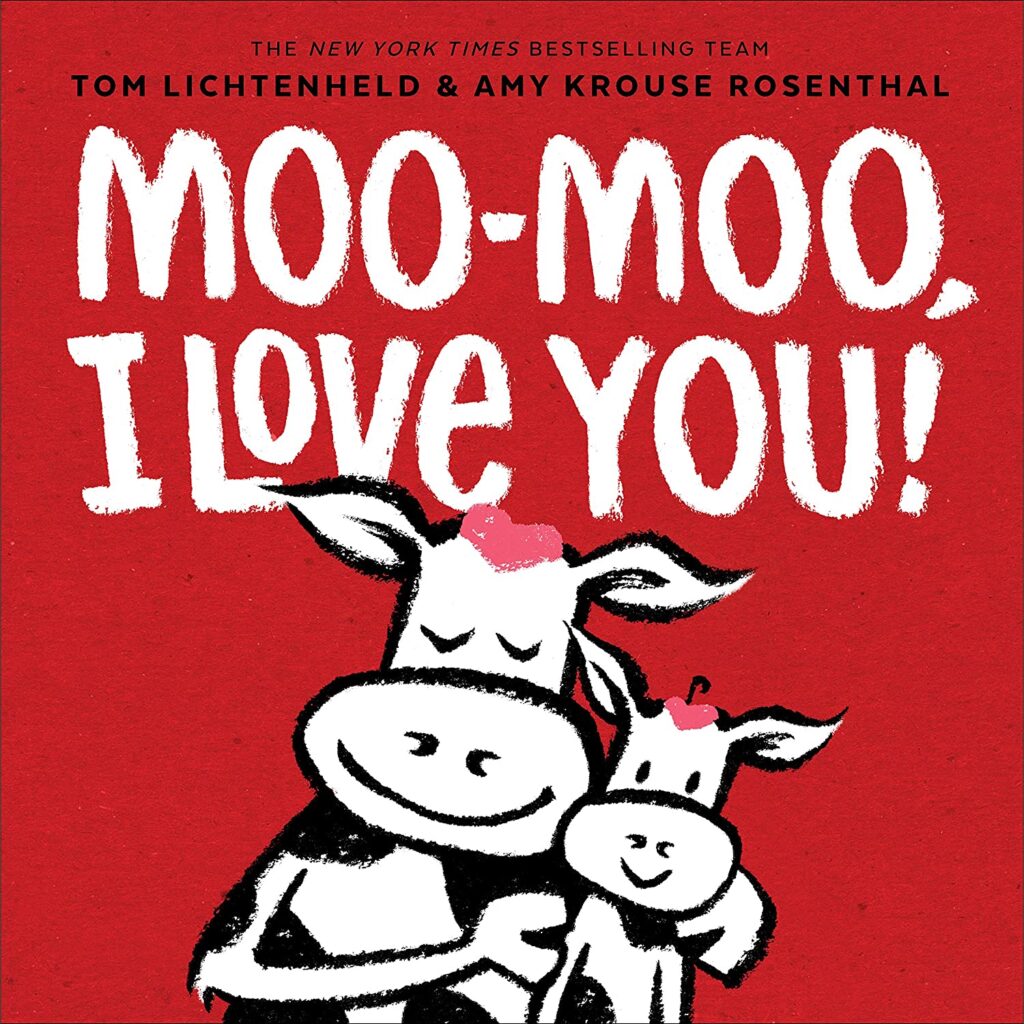
To win a copy of MOO-MOO, I LOVE YOU! by Tom Lichtenheld and Amy Krouse Rosenthal, leave a comment below by May 15th. I’ll announce the winner in my next post.
Thanks for reading, all!
Linda

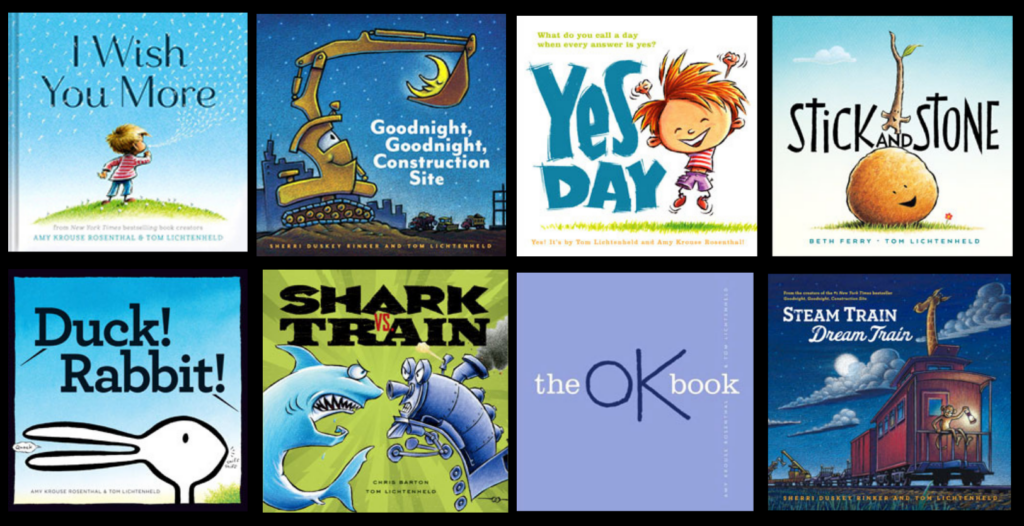

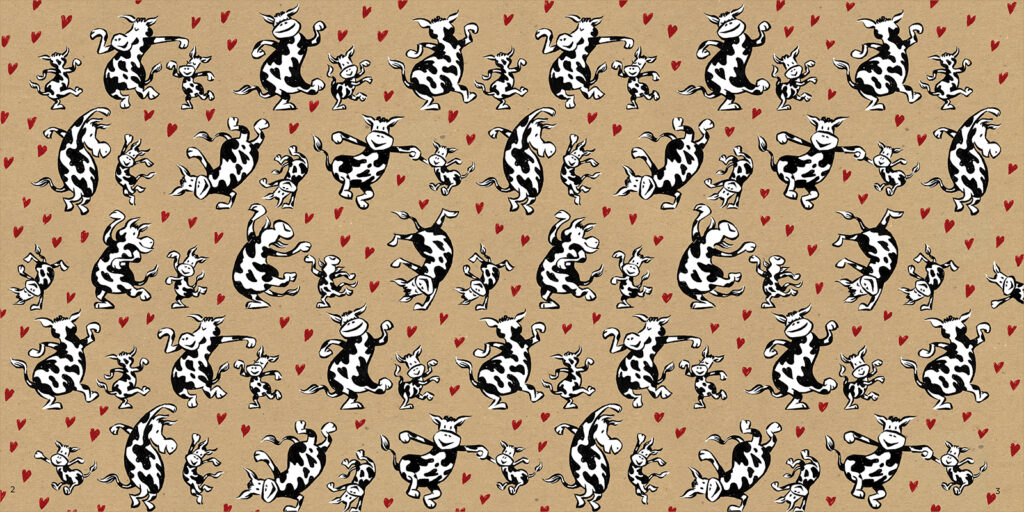

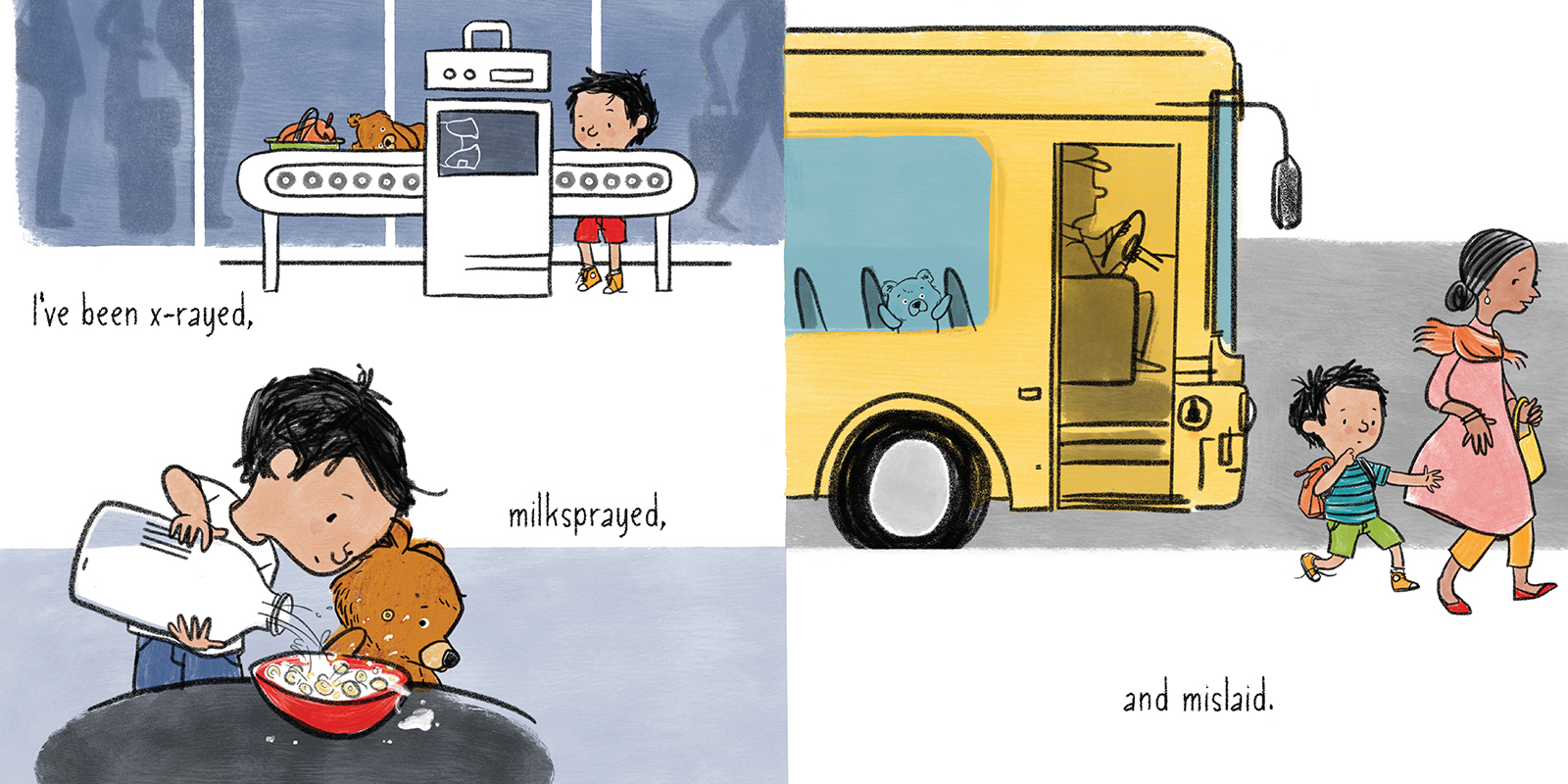
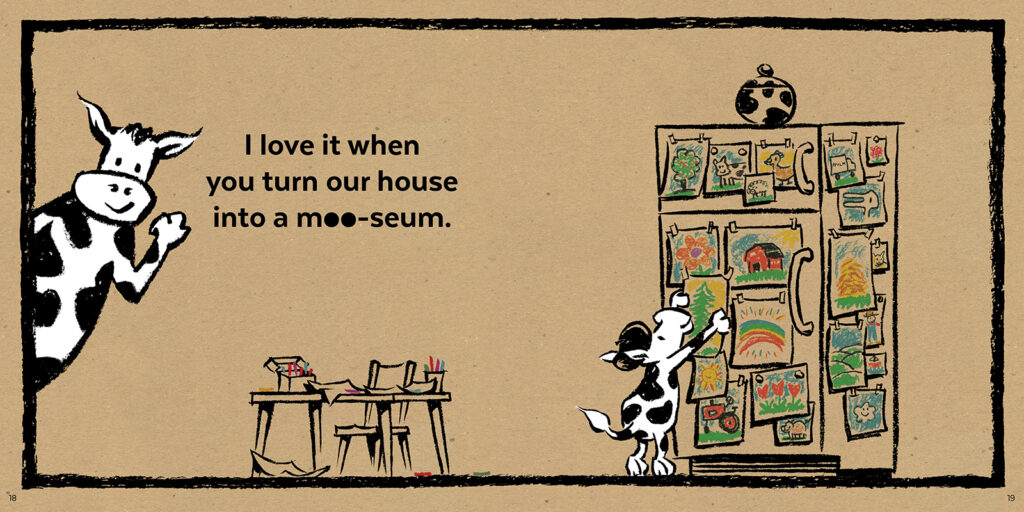
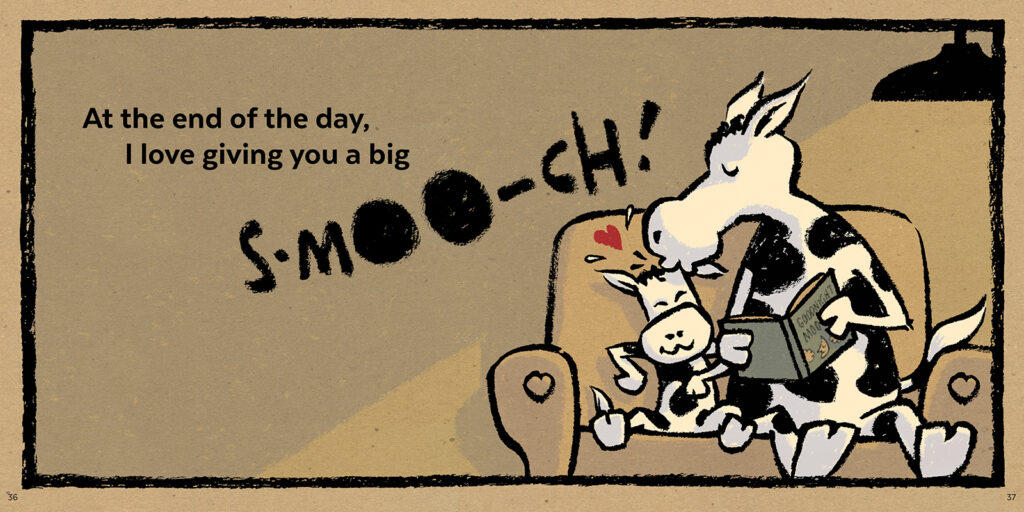
So looking forward to reading Moo-Moo I Love You. It looks like a wonderful tribute.
Awww, I loved all the collaborations between Tom and Amy and I cannot wait to read Moo-Moo I Love You.
Tom is one my all time favorites. Thanks for sharing so much of your process and studio. Thanks, Linda for the great interview.
Swoon! Everything about this interview, but most especially Moo-Moo, I Love You and the spirit of AKR living on. 🙂
Linda and Tom, this interview was GOLD. A two-fer because I went back to read how I Wish You More– my most favorite book of Amy’s and Tom’s collaboration–came about. So I can’t wait to have MOO MOO in my hands! Thank you Tom. I love seeing all those sketches. I also love ALL THE WORLD and look at it for inspiration.
Love all of your books and thanks for sharing your story and workspace. Congrats, Tom, – wishing you continued success!
Goodness – this was awesome. Clearing much more space on the “L” section of my bookshelf to make way for more of Tom’s books!
Books look great, look forward to reading them to my twins!
I’m just gonna add how nice it is to read a manuscript so well-written that page-breaks are crystal clear and pictures spring to life while reading. Pretty sweet for someone who claims writing is not their “primary skill”!!
What a wonderful post and fascinating story behind an amazing creator. Thanks for sharing you time and talents with us, Tom! I can’t wait to read MOO, MOO, I LOVE YOU!
I enjoyed the interview and now feel inspired to keep trying my own manuscript revisions. I can’t wait to read and study more of your books as I learn economy of words and allowing the illustrator add layers to my work.
I’m a longtime fan of Tom’s. Loved reading e-mergency and Shark v Train to my library students. Now I can’t wait to watch Yes! Day.
Oh my goodness! These books are so fun!
Tom, thanks for sharing Moo Moo I Love You with us. I miss Amy’s writing too! I’m going to be a grandma for the first time in September and will for sure share Moo Moo with my granddaughter!
I love this! Thanks for sharing!
MOOve over! I’m off to find this book!
Great language and endpapers and pictures!
Great interview, Tom and Linda! Thanks for sharing, Tom, and congrats on another great book! I can’t wait to read it.
I agree — those dancing cow endpapers are a lot of fun!
Thanks Tom for sharing your process and the gift of working with such wonderful creatives like Amy and Beth. Congrats and continued success.
What a wonderful interview!
I’m always in the moooooood for a Tom and Amy book.
Very interesting! I don’t draw, but enjoyed hearing about his process and success!
I would love to read this to my four-year old!
All so fun and moooooving!
Fantastic! Love the creative workspace!
Thank you for this wonderful interview. Looking forward to all of Tom’s new collaborations and books.
What a wonderful interview! I’m looking forward to reading and sharing Moo-Moo, I love you!
Oh my gosh, the cow smooch page! I love it!
So much to love about this interview, particularly Tom’s sense of gratitude!
Lovely interview! AKR is one of the authors that inspired me to try to start writing for kids way back when. So happy that MOO-MOO, I LOVE YOU! is going to be out in the world. Thanks, Tom! Thanks, Linda for sharing!
I agree, Tom: the solution to MOST problems are often hiding in the woods! Inhale, exhale! Thank you for sharing your collaborations and your inspirations.
Good Night, Good Night Construction Site is one of the ones that has been read over and over and over and over and over and over and over again in this house… Look forward to checking out the others 🙂
What a wonderful, informative interview. Thanks for this.
My almost 4 year old calls me “Moo Moo”–and it would be so special to read this book with him! Thanks for sharing your creativity with us and the world.
Lovely interview. That is so special how you can carry Amy’s book idea forward in Moo Moo I love you! Congratulations!
Moo Moo I love you looks like a sweet book. I’m so glad you were able to go back and realize it.
What a wonderful interview! And the new book looks adorable. Thank you for sharing your process and stories with us.
I just read, MOO-MOO, I LOVE YOU! I love it so MOO-CH! It’s so funny and sweet. I will be reading it to my boys. Thank you for writing it. Blessings for continued success!
My almost-two grandson loves “Moos” , so I think he’ll love this. Can’t go wrong with a collaboration between Tom & Amy!
I’ve enjoyed tom and Amy’s books forever, often purchasing them for their humor. I can’t wait to see Tom and Amy in Moo-moo I love you.
So interesting and inspiring getting a glimpse into your process!
I love the collaboration of this interview. Thank you, Linda & Tom. <3
Can’t wait to read this book!
All of these books are so fun! I love the imagination and creativity that went into each. Thanks so much for sharing with us!
What an inspiring interview! And all of his gratitude and respect for his collaborators and fellow creators. Thanks for sharing!
Thank you for sharing all this amazing information with us!
Such beautiful illustrations and fun, informational content. Thank you!